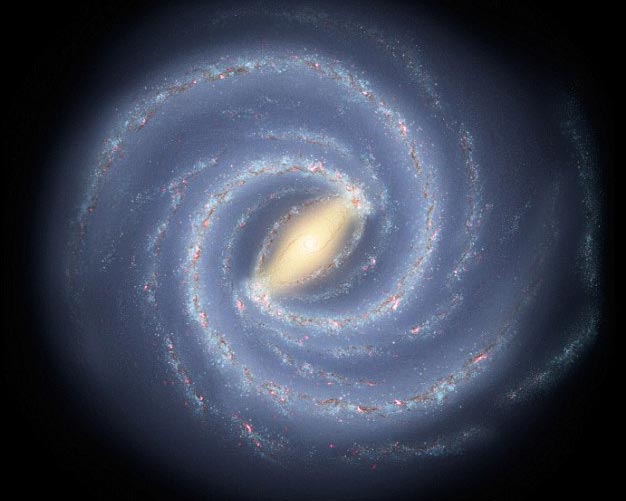Announced the most accurate volume of the whole Milky Way
The Milky Way has been "weighed" to the most accurate level ever and the results can help determine how large our galaxy really is.
The most accurate mass of the whole Milky Way
Previously, the mass of the Milky Way had been conjectured through observing the speed of stars , but the rate of error was very large. The results of the latest study are much more accurately stated using a new measurement method.

According to new research, the Milky Way's mass is 210 billion times the mass of the Sun. To come to this result, researchers have devised a new way to estimate our galactic weight.
Instead of using the speed of galaxies, the team led by Dr. Andreas Küpper of Columbia University (USA) observed a structure similar to the flow of stars originating from a the constellation system (smaller than the galaxy, has a spherical shape and consists of thousands of stars), called Palomar 5.
When studying the upper flow, experts claim to be able to observe "vibrations " created by the mass of the Milky Way. Using Columbia's Yeti supercomputer , they created millions of models to find out what volume level corresponds to the observed fluctuations.
The team eventually came to the conclusion that the mass of the Milky Way, with a width of only 120,000 light-years, is 210 billion times the mass of the Sun.The error of this calculation seems to be 20%.
Meanwhile, previous calculations about the mass of the Milky Way estimate it to be 750 - 1,000 billion times the mass of the Sun, but the error is up to 100%.
However, Dr. Küpper notes that, although his calculation results are three times smaller than previously published figures, they cannot be compared directly to each other by the research groups measuring the areas. different areas of the galaxy."It's like quantifying the population of Manhattan with high accuracy, while other studies quantify the population of the larger area of New York City ," explained Küpper.
Specifically, studies have calculated the mass of a much larger part of the Milky Way, with a width of up to 1.8 million light-years. Dr. Küpper added that it is difficult to see where the Milky Way ends and the neighboring galaxy - Andromeda - begins. But most stars in the Milky Way are within 40,000 light-years.
In the future, scientists hope to use more of the flow of Palomar 5 and other stars to improve the calculation. They also want to delve deeper into how to compare our Milky Way to other galaxies in the universe.
- The mass of the Milky Way
- The movement of stars allows the Milky Way to spin around
- Enjoy the pure Milky Way season
- The galaxy glows brightly when it produces 4,500 times more stars than the Milky Way
- Fun little-known facts about the Milky Way
- The Milky Way had 'devoured' another galaxy billions of years ago
- The Milky Way might contain 100 million black holes
- The Milky Way has a mass of 700 billion times the Sun.
- The Milky Way has died once, we live in its second
- The most accurate thermometer in the world
- The Milky Way has no numerical date
- New map of the Milky Way
 Van Allen's belt and evidence that the Apollo 11 mission to the Moon was myth
Van Allen's belt and evidence that the Apollo 11 mission to the Moon was myth The levels of civilization in the universe (Kardashev scale)
The levels of civilization in the universe (Kardashev scale) Today Mars, the sun and the Earth are aligned
Today Mars, the sun and the Earth are aligned The Amazon owner announced a secret plan to build a space base for thousands of people
The Amazon owner announced a secret plan to build a space base for thousands of people A ghostly object is warping the galaxy that contains Earth
A ghostly object is warping the galaxy that contains Earth  Great ways to relieve stress and beat boredom
Great ways to relieve stress and beat boredom  Does Earth reside in one of the most unusual places in the universe?
Does Earth reside in one of the most unusual places in the universe?  With the development of science, will it be possible for humans to travel across the Milky Way?
With the development of science, will it be possible for humans to travel across the Milky Way?  Revealing the 'time-traveling' galaxy from where the universe began
Revealing the 'time-traveling' galaxy from where the universe began  The Milky Way has swallowed 'the child of the Big Bang'
The Milky Way has swallowed 'the child of the Big Bang' 